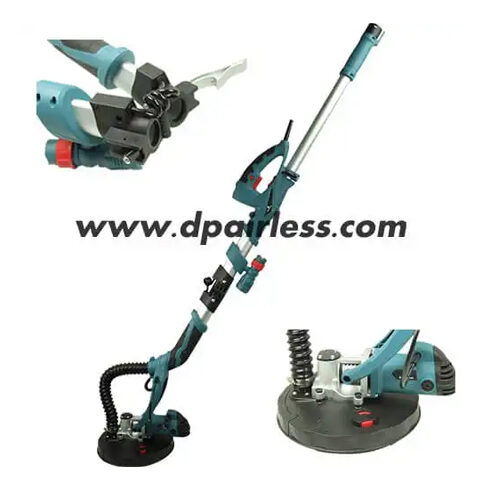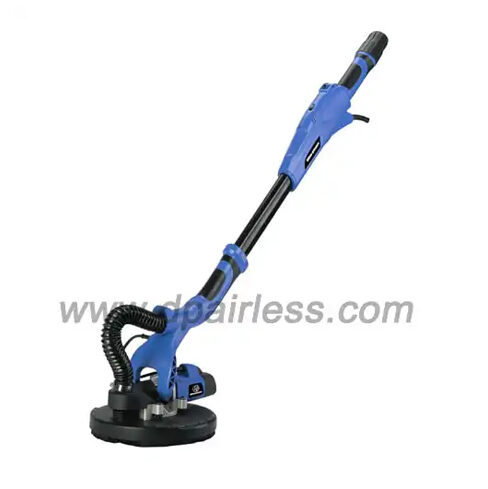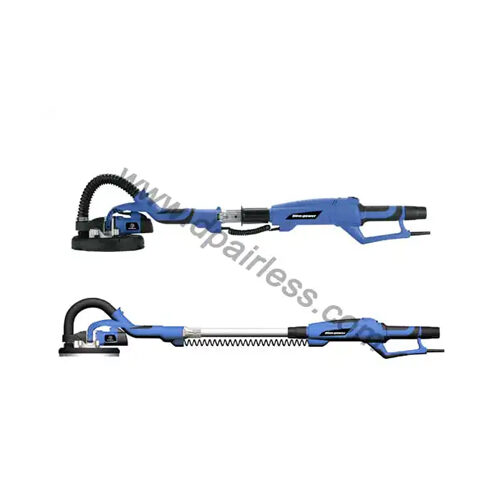HOW TO USE A DRYWALL SANDER
BENEFITS OF THE DRYWALL SANDER
As with any DIY job, having the right tool makes all the difference. The drywall sander has been specifically designed to tackle those big plasterboard walls. Benefits include smooth finishing, high efficiency, dustless environment, light weight and long handle for high reach area even the roofing sanding polishing.

DP-700A Hand-held Drywall Sander

DP-3000 Long Handle Dustless Drywall Sander
Larger surface area
The first thing you’ll notice about your drywall sander is the large, wide base of the sander. This makes sanding / polishing those big walls easier as you are able to attack a larger section of the wall at once. The base is designed to handle those big joints in plasterboard in one easy swipe.

DP-1000F Drywall sander with self-suction system
Dust extraction
The second major benefit of this drywall sander is the in-built dust extraction. This is designed to collect all those fine plasterboard dust particles away from the motor and then expel them into the attached dust collecting bag. This handy feature is what makes using an electric sander on plasterboard possible.
For some professional contractors who use the sanders more often, then prefer to attach the wall sander to a vacuum cleaner. Oboviously the vacuum cleaner has much more power to suck the dust, and the HEPA filter make the dust cleaning easier and faster.

DP-2000F Foldable dust-free drywall sander with LED light
THE POWER OF DUST EXTRACTION
Less mess
The added advantage of the in built dust extraction is that all that messy, hard to clean plaster dust is being cleaned as you work, minimising the mess and clean up time you’ll need to do when the job is done.
Cleaner, healthier air condition
Drywall dust (or dust in general) can be harmful to inhale; when you’re sanding large areas manually all of that dangerous dust is kicked up into the air where you could potentially breath it in. Prolonged exposure to dust-filled air is even linked to an increased chance of developing asthma. By accumulating and storing the dust as you go the drywall sander creates cleaner air that is safer for you and everyone in the room.
TIPS FOR SANDING A DRYWALL
Get off to a fine start
It’s tempting to look at the large area and want to use a coarse paper to speed up your job, but most modern plaster is rather soft. Using a heavy-grit paper can potentially leave marks on your wall. Start fine and move to a coarser paper if needed.
Don’t push the dry wall sander with strong power, because strong power pushing will Shovel off the wall, that will make the wall uneven and ugly. Just grip the handle tightly, let the round pad moving slightly going round and round.
Fill In the gaps
Rather than trying to sand out any big ridges or gouges, it can be easier to and a coat of joint compound to even it out. This avoids the risk of over-sanding the areas surrounding the problem.
Shine a light on imperfections
Use a light to expose dings, pits and imperfections, circle them with a pencil as you go and then pick up your sander and re-sand any problem areas.
Prime time sanding
Many over eager beginners will skip sanding after priming but it’s a risky choice. Sanding after priming removes any fuzz or lumps that may cause unevenness in your paint job.
WHICH VACUUM CLEANER SHOULD I USE FOR DRYWALL SANDING?
When it comes to indoor construction, drywall sanding is among the messiest jobs. It can create a great deal of fine dust covering your work space, and on top of the obvious nuisance of cleaning it up, there’s also the health hazard these kinds of dusty environments can create for anyone working around the area. Traditional Shop-Vacs have long been the go-to, but are they really the best vacuum for the job? The short answer is no. Due to the nature of the paint on drywalls and the fine dust it creates, your average Shop-Vac’s filtration can experience quick burnout since their filter system clogs easily. Add to that, Shop-Vacs aren’t cut out to trap dust clouds while you’re working.
So which vacuum should you use in your drywall sanding job? Here are some tips to make your job easier and safer than ever…
- Choose an industrial vacuum cleaner that can attach to your wall sander tools such as sanding blocks, bazookas, and more. This will give you the peace of mind that fine dust will be removed directly from the sanding surface before it even has a chance at escaping into the open air.
- Filtration matters. Clean filtration, 99% efficient @ 0.5 Micron captures fine without the hassle of clogs. Their long filter life also reduces expensive filter changes while keeping your vacuum’s performance top notch.
- Look for an industrial vacuum that’s versatile. You’ll want a vacuum that’s powerful and efficient enough to pull off any point of source extraction, but also one that can be used for general housekeeping to get to hard to reach places when the dust really flies in all directions.
- To keep workers safe from breathing in harmful materials, use a vacuum cleaner with HEPA filtration. This provides air purification so that only clean air is returned into the room while working.
Depending on the frequency you’ll be using the vacuum as well as the size of your dry wall sanding job, intermittent and continuous duty portable vacuums alongside central vacuum systems are capable of providing you with a dust-free solution. What’s important is understanding that handling drywall sanding dust properly is an investment that will keep workers safe, and provide a cost-effective decision in a dust removal remedy in the long run.
After sanding the drywall, use the high pressure paint sprayer airless pump to spray the paint onto the wall continiously and equally, the constent stable high pressure will atomize the paint into very tiny fog and apply onto the wall equallly. That sprayer is different from traditional air sprayer, we call this airless spray.

DP-506 Vacuum cleaner 38L with stainless steel tank

DP-506 connecting with drywall sander for construction work










































